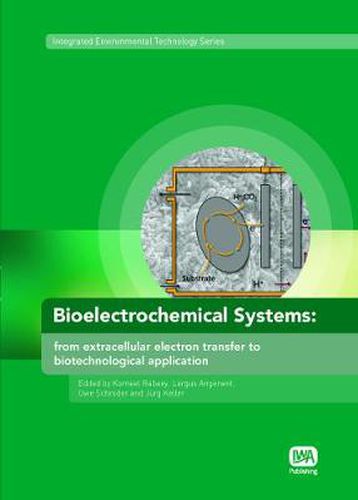Readings Newsletter
Become a Readings Member to make your shopping experience even easier.
Sign in or sign up for free!
You’re not far away from qualifying for FREE standard shipping within Australia
You’ve qualified for FREE standard shipping within Australia
The cart is loading…






In the context of wastewater treatment, Bioelectrochemical Systems (BESs) have gained considerable interest in the past few years, and several BES processes are on the brink of application to this area. This book, written by a large number of world experts in the different sub-topics, describes the different aspects and processes relevant to their development.
Bioelectrochemical Systems (BESs) use micro-organisms to catalyze an oxidation and/or reduction reaction at an anodic and cathodic electrode respectively. Briefly, at an anode oxidation of organic and inorganic electron donors can occur. Prime examples of such electron donors are waste organics and sulfides. At the cathode, an electron acceptor such as oxygen or nitrate can be reduced. The anode and the cathode are connected through an electrical circuit. If electrical power is harvested from this circuit, the system is called a Microbial Fuel Cell; if electrical power is invested, the system is called a Microbial Electrolysis Cell.
The overall framework of bio-energy and bio-fuels is discussed. A number of chapters discuss the basics - microbiology, microbial ecology, electrochemistry, technology and materials development. The book continues by highlighting the plurality of processes based on BES technology already in existence, going from wastewater based reactors to sediment based bio-batteries. The integration of BESs into existing water or process lines is discussed. Finally, an outlook is provided of how BES will fit within the emerging biorefinery area.
$9.00 standard shipping within Australia
FREE standard shipping within Australia for orders over $100.00
Express & International shipping calculated at checkout
In the context of wastewater treatment, Bioelectrochemical Systems (BESs) have gained considerable interest in the past few years, and several BES processes are on the brink of application to this area. This book, written by a large number of world experts in the different sub-topics, describes the different aspects and processes relevant to their development.
Bioelectrochemical Systems (BESs) use micro-organisms to catalyze an oxidation and/or reduction reaction at an anodic and cathodic electrode respectively. Briefly, at an anode oxidation of organic and inorganic electron donors can occur. Prime examples of such electron donors are waste organics and sulfides. At the cathode, an electron acceptor such as oxygen or nitrate can be reduced. The anode and the cathode are connected through an electrical circuit. If electrical power is harvested from this circuit, the system is called a Microbial Fuel Cell; if electrical power is invested, the system is called a Microbial Electrolysis Cell.
The overall framework of bio-energy and bio-fuels is discussed. A number of chapters discuss the basics - microbiology, microbial ecology, electrochemistry, technology and materials development. The book continues by highlighting the plurality of processes based on BES technology already in existence, going from wastewater based reactors to sediment based bio-batteries. The integration of BESs into existing water or process lines is discussed. Finally, an outlook is provided of how BES will fit within the emerging biorefinery area.